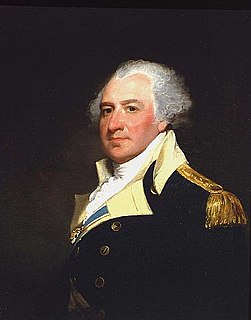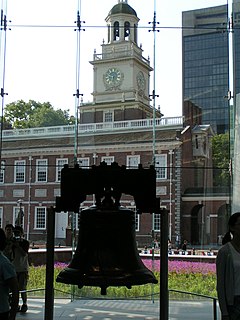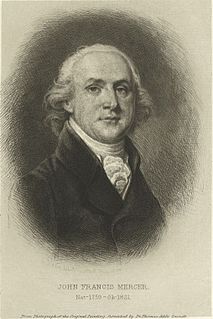
John Hanson was a merchant and public official from Maryland during the era of the American Revolution. In 1779, Hanson was elected as a delegate to the Continental Congress after serving in a variety of roles for the Patriot cause in Maryland. He signed the Articles of Confederation in 1781 after Maryland finally joined the other states in ratifying them. In November 1781, he was elected as first President of the Confederation Congress, following ratification of the articles. For this reason, some of Hanson's biographers have argued that he was actually the first holder of the office of president.

Thomas Mifflin was an American merchant and politician from Philadelphia, Pennsylvania. He served in a variety of roles during and after the American Revolution, several of which qualify him to be counted among the Founding Fathers. He was the first Governor of Pennsylvania, serving from 1790 to 1799.

The Continental Congress, also known as the Philadelphia Congress in its early iterations, was a convention of delegates called together from the Thirteen Colonies. The Congress met from 1774 to 1789 in three incarnations and became the governing body of the new United States of America during the American War of Independence. Much of what is known today about the activities and deliberations of the Continental Congresses comes from the yearly log books printed by the Continental Congress called Resolutions, Acts and Orders of Congress, which gives a day-to-day description of debates and issues.

Robert Morris, Jr. was an English-born merchant and a Founding Father of the United States. He served as a member of the Pennsylvania legislature, the Second Continental Congress, and the United States Senate, and he was a signer of the Declaration of Independence, the Articles of Confederation, and the United States Constitution. From 1781 to 1784, he served as the Superintendent of Finance of the United States, becoming known as the "Financier of the Revolution." Along with Alexander Hamilton and Albert Gallatin, he is widely regarded as one of the founders of the financial system of the United States.
John Henry was the eighth Governor of Maryland and member of the United States Senate. He was born at his family's estate (Weston), located near Vienna in Dorchester County.

Thomas Johnson was an 18th century American judge and politician. He participated in several ventures to support the Revolutionary War. Johnson was the first (non-Colonial) Governor of Maryland, a delegate to the Continental Congress, and an Associate Justice of the Supreme Court. Johnson suffered from a myriad of health issues. He was the first person appointed to the Court after its original organization and staffing with six justices. Johnson's tenure on the Supreme Court lasted only 163 days, which makes him the shortest-serving Justice in U.S. history.

The President of the Continental Congress was the presiding officer of the Continental Congress, the convention of delegates that emerged as the first (transitional) national government of the United States during the American Revolution. The president was a member of Congress elected by the other delegates to serve as a neutral discussion moderator during meetings of Congress. Designed to be a largely ceremonial position without much influence, the office was unrelated to the later office of President of the United States. Upon the ratification of the Articles of Confederation in March 1781, the Continental Congress became the Congress of the Confederation. The membership of the Second Continental Congress carried over without interruption to the First Congress of the Confederation, as did the office of president.

The Second Continental Congress was a convention of delegates from the Thirteen Colonies that started meeting in the spring of 1775 in Philadelphia, Pennsylvania. It succeeded the First Continental Congress, which met in Philadelphia between September 5, 1774, and October 26, 1774. The Second Congress managed the Colonial war effort and moved incrementally towards independence. It eventually adopted the Lee Resolution which established the new country on July 2, 1776, and it agreed to the United States Declaration of Independence on July 4, 1776. The Congress acted as the de facto national government of the United States by raising armies, directing strategy, appointing diplomats, and making formal treaties such as the Olive Branch Petition.
The Annapolis Convention was an Assembly of the Counties of Maryland that functioned as the colony's provincial government from 1774 to 1776 during the early days leading up to the American Revolution. After 1775, it was officially named the Assembly of Freemen.
William Henry was an American gunsmith, engineer and merchant from Lancaster, Pennsylvania, and a delegate for Pennsylvania to the Continental Congress in 1784, 1785, and 1786. Henry is also noted for his contributions in development of the first steam engines.

Thomas Sim Lee was an American planter and statesman of Frederick County, Maryland. Although not a signatory to the Declaration of Independence, the Articles of Confederation or the US Constitution, he was an important participant in the process of their creation. Thomas Sim Lee was the second State Governor of Maryland, serving twice, from 1779 to 1783 and again from 1792 to 1794. Thomas Sim Lee also served as a delegate of Maryland in the Congress of the Confederation in 1783 and was a member of the House of Delegates in 1787. He worked closely with many of the Founding fathers and played himself an important part in the birth of his state and the nation.
John Rogers was an American lawyer and judge from Upper Marlboro, Maryland. He was a delegate for Maryland to the Continental Congress in 1775 and 1776, and Maryland's Chancellor from 1778 until his death.

Independence National Historical Park is a United States National Park in Philadelphia that preserves several sites associated with the American Revolution and the nation's founding history. Administered by the National Park Service, the 55-acre (22 ha) park comprises much of Philadelphia's most-visited historic district. The park has been nicknamed "America's most historic square mile" because of its abundance of historic landmarks, and the park sites are located within the Old City and Society Hill neighborhoods of Philadelphia.

John Hoskins Stone was an American planter, soldier, and politician from Charles County, Maryland. During the Revolutionary War he led the 1st Maryland Regiment of the Continental Army. After the war he served in the state legislature and was the seventh Governor from 1794 to 1797.

John Francis Mercer was an American lawyer, planter, and politician from Virginia and Maryland.

William Vans Murray was an American lawyer, politician, and statesman. He served in the Maryland House of Delegates from 1788 to 1790, and in the United States House of Representatives from 1791 to 1797. He was the United States Ambassador to the Netherlands from 1797 to 1801.

Early American currency went through several stages of development during the colonial and post-Revolutionary history of the United States. Because few coins were minted in the thirteen colonies that became the United States, foreign coins like the Spanish dollar were widely circulated. Colonial governments sometimes issued paper money to facilitate economic activities. The British Parliament passed Currency Acts in 1751, 1764, and 1773 that regulated colonial paper money.

The Congress of the Confederation, or the Confederation Congress, formally referred to as the United States in Congress Assembled, was the governing body of the United States of America that existed from March 1, 1781, to March 4, 1789. A unicameral body with legislative and executive function, it was composed of delegates appointed by the legislatures of the several states. Each state delegation had one vote. It was preceded by the Second Continental Congress (1775–1781) and governed under the newly adopted Articles of Confederation and Perpetual Union, which were proposed in 1776–1777, adopted by the Continental Congress in July 1778 and finally agreed to by a unanimous vote of all thirteen states by 1781. It was held up by a long dispute over the cession of western territories beyond the Appalachian Mountains to the central government led by Maryland and a coalition of smaller states without western claims. The plan was introduced by Maryland politician John Hanson and was referred to as 'The Hanson Plan'. The newly reorganized Congress at the time continued to refer itself as the Continental Congress throughout its eight-year history, although modern historians separate it from the earlier bodies, which operated under slightly different rules and procedures until the later part of American Revolutionary War. The membership of the Second Continental Congress automatically carried over to the Congress of the Confederation when the latter was created by the ratification of the Articles of Confederation. It had the same secretary as the Second Continental Congress, namely Charles Thomson. The Congress of the Confederation was succeeded by the Congress of the United States as provided for in the new Constitution of the United States, proposed September 17, 1787, in Philadelphia and ratified by the states through 1787 to 1788 and even into 1789 and 1790.
Thomas Bayly was a U.S. Congressman from the eighth district of Maryland, serving from 1817 to 1823.

The drafting of the Constitution of the United States began on May 25, 1787, when the Constitutional Convention met for the first time with a quorum at the Pennsylvania State House in Philadelphia, Pennsylvania to revise the Articles of Confederation, and ended on September 17, 1787, the day the Constitution drafted by the convention's delegates to replace the Articles was adopted and signed. The ratification process for the Constitution began that day, and ended when the final state, Rhode Island, ratified it on May 29, 1790. In addition to key events during the Constitutional Convention and afterward while the Constitution was before the states for their ratification, this timeline includes important events that occurred during the run-up to the convention and during the nation's transition from government under the Articles of Confederation to government under the Constitution, and concludes with the unique ratification vote of Vermont, which at the time was a sovereign state outside the Union. The time span covered is 5 years, 9 months, from March 25, 1785 to January 10, 1791.

















